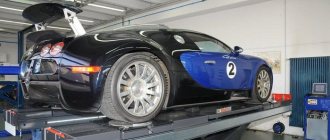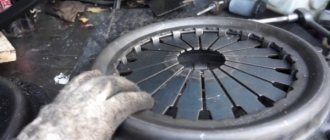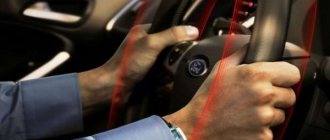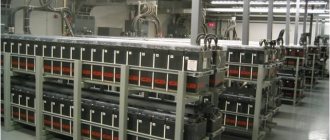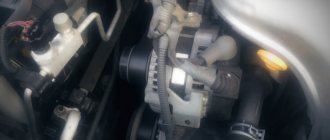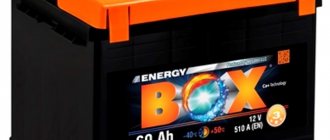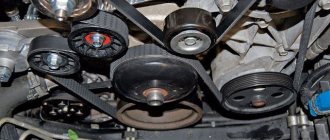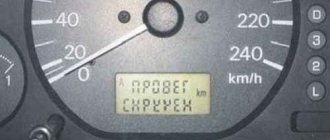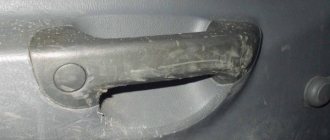When you buy a car, you buy not only a convenient way of transportation, but also a whole bunch of problems. One of the most unpleasant and most common is rust. Millions of people around the world are wondering how to remove rust from metal.
completely rusty car
It’s not surprising, because the body is a rather expensive part of any car, and this is its face. Removing corrosion from a body requires a lot of money, as well as time and effort. There is an opinion that only professionals at a service station can cope with this problem. Many, however, know how to remove corrosion from a car body with their own hands. This is what the next article will be devoted to.
You've all heard about corrosion and how it affects metal. Therefore, it is very unpleasant to see your worst enemy on your iron horse. Since paintwork doesn't last forever, particles of sand and gravel constantly bombard the car's underbody and sills; rust sooner or later settles in any car.
This problem can even occur with new cars - in places where the painting was done without due care. If you see traces of corrosion on your new or used car, take care of this problem immediately, because everything will only get worse.
If you don't want your car to fall apart over time due to imperfect physical laws, be aware of the high-risk areas where rust usually damages first. We will also talk about them below.
Metal corrosion: why the body rusts and how to deal with it
What is a body? The structure is made of thin sheet metal, with different alloys and with many welded joints. And we must not forget that the body is used as a “minus” for the on-board network, that is, it constantly conducts current. Yes, it simply must rust! Let's try to figure out what is happening to the car body and how to deal with it.
What is rust?
Corrosion of iron or steel is the process of metal oxidation with oxygen in the presence of water. The output is hydrated iron oxide - a loose powder that we all call rust.
Destruction of a car body is considered a classic example of electrochemical corrosion. But water and air are only part of the problem. In addition to ordinary chemical processes, galvanic pairs that arise between electrochemically inhomogeneous pairs of surfaces play an important role in it.
I can already see a bored expression appearing on the faces of humanities readers. Don’t be scared by the term “galvanic couple” - we’re not going to give a chemistry lecture and won’t give complex formulas. This very pair in a particular case is just a combination of two metals.
Metals, they are almost like people. They don't like it when someone else clings to them. Imagine yourself on a bus. A rumpled man pressed against you, who yesterday celebrated some kind of High-Rise Fitter's Day with friends. In chemistry this is called an unacceptable galvanic couple. Aluminum and copper, nickel and silver, magnesium and steel. These are “sworn enemies” who, in a close electrical connection, will very quickly “devour” each other.
In fact, no metal can withstand close contact with a stranger for long. Think for yourself: even if a curvy blonde (or a slender brown-haired woman, depending on your taste) is pressed against you, it will be pleasant at first. But you won’t stand like this all your life. Especially in the rain. What does the rain have to do with it? Now everything will become clear.
There are many places in a car where galvanic couples are formed. Not unacceptable, but “ordinary”. Welding points, body panels made of different metals, different fasteners and assemblies, even different points on the same plate with different mechanical surface treatments. There is always a potential difference between them all, which means that in the presence of an electrolyte there will be corrosion.
Wait, what is an electrolyte? An inquisitive motorist will remember that this is some kind of caustic liquid that is poured into batteries. And he will be only partly right. An electrolyte is generally any substance that conducts current. A weak acid solution is poured into the battery, but it is not necessary to pour acid on the car to speed up corrosion. Ordinary water performs the functions of an electrolyte perfectly. In its pure (distilled) form, it is not an electrolyte, but pure water does not occur in nature.
Thus, in each formed galvanic couple, under the influence of water, the destruction of the metal begins on the anode side - the positively charged side. How to overcome this process? We cannot prevent metals from corroding from each other, but we can exclude the electrolyte from this system. Without it, “permissible” galvanic couples can exist for a long time. Longer than the car lasts.
How do manufacturers fight rust?
The simplest method of protection is to cover the metal surface with a film through which the electrolyte will not penetrate. And if the metal is also good, with a low content of impurities that promote corrosion (for example, sulfur), then the result will be quite decent.
But don't take the words literally. The film is not necessarily polyethylene. The most common type of protective film is paint and primer. It can also be created from metal phosphates by treating the surface with a phosphating solution. The phosphorus-containing acids in its composition will oxidize the top layer of metal, creating a very strong and thin film.
By covering the phosphate film with layers of primer and paint, you can protect the car body for many years; it was according to this “recipe” that bodies were prepared for decades, and, as you can see, quite successfully - many cars produced in the fifties and sixties were able to survive to this day.
But not all, because over time the paint is prone to cracking. At first the outer layers fail, then the cracks reach the metal and phosphate film. And in case of accidents and subsequent repairs, coatings are often applied without maintaining the absolute cleanliness of the surface, leaving small points of corrosion on it, which always contain a little moisture. And under the film of paint a new source of destruction begins to appear.
Prevent and neutralize
The easiest way to prevent the spread of rust on the body is to prevent its occurrence. To do this, you need to treat the body with anticorrosive. But here I would like to note that it is simply impossible to exclude its formation 100%. The anti-corrosion coating will preserve the body for a longer time, but still, after a few years, when the protective layer becomes very thin, saffron milk caps will begin to appear.
@carhelper.ch
Why does a car rust and how to deal with it?
Many owners of new cars don’t even think about rust. They think that this is a problem with machines with solid experience. Be that as it may, rust begins to “attack” the car immediately after leaving the assembly line, even if the car body is galvanized. How to prevent rust from damaging your car and which method to choose? About this in our article today.
Why does the car body rust?
There are several answers to this question. Firstly, the car body consists entirely of a thin layer of various metals, which of course are susceptible to rust on their own. Body parts are connected by welding - this fact makes the car even weaker before rust. Secondly, this entire metal structure constantly conducts current, which leads to electrochemical corrosion. And thirdly, the car is constantly exposed to chemical and mechanical attacks during operation, which quickly weakens any, even the most reliable protection against metal corrosion.
What is rust and why does it “love” cars so much? Corrosion is the process of metal oxidation under the influence of oxygen and moisture. When these three ingredients combine, the result is hydrated iron oxide, a loose, brown powder that we all come to call rust. But, in the case of a car, air and water are only a small part causing corrosion. The constant effect of current on the metal parts of the car creates a galvanic couple - causing electrochemical corrosion, which is formed when current passes through heterogeneous pairs of surfaces. The galvanic couple in a car are different metal alloys used to create the body.
If we delve a little deeper into the chemistry course, we will find out that aluminum and copper, nickel and silver, magnesium and steel cannot be combined. These pairs of metals are galvanic, that is, they are undesirable to each other and, when current is carried out, they simply begin to destroy each other, which manifests itself in the form of corrosion.
Even if the metals do not “hate” each other, the combination of two different types of metal always leads to corrosion. And if moisture gets into them, the rusting process starts much faster. Almost the entire car consists of places where different metals are connected. These are different panels, welding points, fasteners, even the same metal, processed in different ways, is perceived as different, foreign. Foreign metals always have different electrical potentials; add an electrolyte and corrosion appears.
An electrolyte is any liquid substance that conducts current. Simply put, rain or fresh water is an excellent electrolyte. And water, as you know, gets into all possible places and compartments of the car. Based on this, corrosion begins to form everywhere inside and outside the car as soon as water gets there. That is, immediately, as soon as you go outside for the first time.
How to make your own rust remover
You can make a corrosion converter yourself. To do this, you need to mix regular tap water with acid (ethanedioic or citric) in equal quantities. Next, you need to add a little soda to this mixture (add a little more than half a teaspoon of powder per liter of liquid). To eliminate oxidation with this solution, you need to moisten a piece of cloth with it and treat the surface.
Please note: Wearing gloves is highly recommended to avoid chemical burns. Contact with the skin of either a purchased or homemade converter can result in injury.
To get rid of the problem more effectively, you can use a substance based on a solution of zinc salt. It deals with the oxidized area more quickly, destroying any rust.
It’s easy to get rid of rust on doors; the main thing is to do it in a timely manner so as not to start an irreversible process.
Car corrosion
Car corrosion is the destruction of metal parts of a car (body, etc.) under the influence of an aggressive environment, due to irrational design and careless handling.
Every year the size of the global vehicle fleet is constantly growing. There was a time when tens or hundreds of people on the planet had a car. But progress was not long in coming. Nowadays, a car is no longer a luxury, but a necessity for many people.
As the number of cars increases, their performance characteristics also improve.
The average lifespan of a car is about 15 – 20 years (depending on many factors). The service life is significantly reduced when the machine is exposed to aggressive operating conditions. Most often, a car fails due to corrosion damage (corrosion) of its parts: body, pipelines, brake system elements, frames and other important components. Some parts can be replaced or repaired, while others are unsuitable for further use.
Internal and through corrosion - preventive treatment
The most unpleasant destruction of the body, which requires quick and professional intervention, is through corrosion. This process requires certain skills in welding and the availability of high-quality equipment for professional body restoration. If you do not have the equipment and skills, through corrosion should only be eliminated with the help of specialists. But you can carry out treatment that will extend the life of the body quite simply and right now. All you need is mastic, a brush and a lot of free time. The processing process is as follows:
- to process the bottom you need a hole, first you need to clean off the old layers of antior and dirt and open the bottom with simple bitumen mastic;
- wheel arches - it is necessary to remove the fender liners, clean the metal parts from the beginnings of corrosion and open the metal with anti-corrosion agent;
- the internal parts of the doors can be opened with a special mixture by removing the cards on the inside and treating the exposed metal parts;
- the cavities of the trunk and hood inside also need to be processed; they are quite difficult to restore further and can only be replaced;
- It would be a good idea to treat the floor in the car by removing all the seats, carpet and anti-noise, at the same time you can change the coating, which protects against unnecessary sounds in the car;
- the engine compartment can be treated with mastic at the seams - they are the main localization of corrosion here.
You should also pay special attention to the frame, side members and other supporting structures. They are made of high-quality materials and can last quite a long time, but this does not mean that you can simply forget about their existence. If you want to use your car for a long time, it’s time to take care of its condition and carry out high-quality body treatment processes. Otherwise, you will soon have to turn to specialists with a request to eliminate the effects of corrosion. This will be very expensive, and without such services the car will simply fall apart, quickly enough. We offer a video with specific solutions for local painting of body parts due to rust:
Optimal conditions for car storage
In order for your car to last a long time and not be subject to corrosion, you must adhere to several basic storage rules. The room in which the machine is located must be dry, well ventilated and, preferably, heated in the cold season. This is necessary so that the moisture on the surface of the car quickly evaporates. A wet car (for example, after rain or snow) should dry thoroughly in the garage. Electrochemical corrosion is impossible in the absence of moisture. Good ventilation of the garage is ensured by the presence of ventilation slots in the doors, through holes between garages combined together, and a ventilation hole in the roof of the room.
Storing a car in a damp, poorly ventilated area is much more dangerous than simply storing it outdoors. The car is ventilated in the air, and in a damp garage the best conditions are created for electrochemical corrosion of the metal.
When storing a car under an awning, it is necessary that there is at least a small air gap between the surface of the body and the awning. This is necessary so that moisture from the surface evaporates faster. Also, special ventilation holes are required in the awning.
Prevention
Whatever method you have to use to combat rust on the body, it is still a labor-intensive and expensive process. In addition, removing rust from metal is only half the battle, because after that you will also have to putty, paint and polish the affected area again. And this is also very expensive and not easy. Thus, it becomes clear that the best fight against corrosion is to prevent its occurrence. In order to protect the body from rust, you need to take a number of actions.
- It is necessary to treat the underbody of the car, the inside of the wings, sills and doors with anti-corrosion paint. This will protect them from exposure to salt and reagents during the winter. You can do this yourself, but you need to remember that each body element has its own protection. That is, for the bottom it is one composition, for the thresholds another, and so on. A car cosmetics store can tell you what types of compounds are suitable for a particular car.
- The body must also be coated with protective pastes. There are many of them in stores. Manufacturers of these products offer protection that retains its properties for 3 to 12 months, depending on the type of substance. This paste is applied manually with a dry microfiber cloth. But it is better to use a special polishing machine for this. Polishes coat the paint with a thin layer of substance that protects the varnish from water and minor scratches. You can buy such protective mixtures in auto care stores.
- The way you store your car is very important for protecting the body from rust. Ideally, this should be an open, well-ventilated and heated parking lot. If the owner has a garage, then care must be taken to ensure good ventilation in it so that the air does not stagnate. Simply storing your car outside in the rain and snow will definitely have a negative impact on the condition of the body. Therefore, you need to have at least a cover to protect your car from bad weather.
- The car needs to be washed regularly. Especially in winter, when a salty reagent accumulates on the paint and bottom, corroding the iron.
You can get rid of rust in various ways. To do this, you can use improvised means and special compounds. In advanced cases, they resort to mechanical or electrochemical cleaning methods. Sometimes you have to completely cut out the damaged areas.
Car corrosion
A car can be subject to both chemical and electrochemical corrosion. A striking example of chemical corrosion is the destruction of the engine exhaust tract under the influence of exhaust gases. Also, gas chemical corrosion of a car can be observed in its fuel system if the fuel liquids contain impurities of hydrogen sulfide, mercaptans, elemental sulfur, etc. In this case, the metal bearing shells corrode.
But in most cases, the car is still susceptible to electrochemical corrosion, which affects more components of the car and occurs only in cases where there is an electrolyte on the metal surface. Research has proven that under atmospheric conditions there is always a film of moisture on the surface of any metal. Its thickness depends on temperature, air humidity and other indicators.
Any metal surface of a car is electrochemically inhomogeneous (some areas have a difference in electrode potentials). A surface with a lower electrode potential (in contact with an electrolyte) becomes anodic, and a surface with a higher one becomes cathodic. Each pair of inhomogeneous sections forms a short-circuited galvanic cell. There are a lot of such working galvanic elements on the surface of the car. In this case, only the anode sections are destroyed. Potential differences can arise for many reasons, which can be read about in articles about external and internal factors of electrochemical corrosion.
If the metal surface is not protected, then conditions for corrosion processes to occur always exist. The vehicle may be subject to local (spot, pitting, thread-like, through, intercrystalline, pitting, subsurface) corrosion damage.
Car corrosion, according to the conditions of its occurrence, is divided into:
— corrosion in non-electrolytes (oil and fuel systems);
— gas (destruction of the exhaust pipe, muffler, on the chamfers of the exhaust valve plates in the combustion chambers);
— in electrolytes (in places of stagnation of moisture);
— contact (places of contact of metals with different electrode potentials);
— atmospheric (during storage, transportation and operation of the vehicle);
- slotted (in gaps and narrow crevices);
— structural (in places with heterogeneity of metal composition, for example, after welding);
— under friction conditions (observed in friction units where there is a corrosive environment);
— under tension (on surfaces that are under tension);
— biocorrosion (under the influence of microorganisms or their metabolic products).
Almost all components of the car are exposed to corrosion. To reduce the cost of a car (to make it more accessible to all consumers), manufacturers are increasingly using very thin steel sheets for the body. On such machines, the first corrosion damage (especially through) appears after 1.5 – 2 years of operation. Most of them are located on the internal (hidden) parts of the body. In such areas, zones of stagnation of moist air are formed (especially at high air humidity). When cooling, moisture begins to concentrate on the surface of the metal itself. This mechanism can be represented as follows. The car, heated while driving, is left overnight in an open parking lot. The machine gradually cools down and its temperature drops below the dew point. The moisture contained in the air settles first on the roof of the body, and then on the entire surface. When there is a film of moisture on the surface, all protective coatings experience its destructive effects. The negative impact is enhanced by air impurities and contaminants of the car itself, which turn into a wet film. For cars stored outdoors, the most dangerous time is morning. The air temperature rises and moisture begins to slowly evaporate. During the drying process, the concentration of harmful substances in the electrolyte increases. Just before complete drying, protective and decorative coatings are exposed to rather aggressive solutions of acidic electrolytes.
Various types of gaps, cracks in the paintwork, contact welding seams of the body, etc. are very dangerous for the car. Moisture accumulates and stagnates in them. Crevice corrosion develops. The oxygen that is in the gap is very quickly consumed by corrosion processes. As a result, zones are formed that are depleted of oxygen (anode) and with normal access (cathode). A galvanic element appears.
Corrosion prevention and periodic maintenance
Using the most advanced technologies and methods of corrosion protection, Hyundai produces high quality cars. However, to ensure long-term corrosion protection for your Hyundai, your help and assistance is also required.
Common Causes of Corrosion
The most common causes of corrosion on your car are:
– road salt, dirt and moisture accumulating under the bottom of the car; – chips of paint or protective coatings from stones, gravel, minor chips and dents, leaving unprotected metal exposed to corrosion.
Moisture causes corrosion
Moisture creates conditions for the most intense corrosion. For example, the occurrence of corrosion is significantly accelerated by high humidity, especially at freezing temperatures. Under such conditions, corrosive materials come into contact with vehicle surfaces through poorly evaporated moisture. Dirt is a common cause of corrosion because it dries slowly and allows moisture to come into contact with the vehicle. Even if dirt appears dry, it can still contain moisture and promote corrosion. High temperatures can also contribute to corrosion of poorly ventilated parts of the car, on which moisture can settle. For these reasons, it is very important to keep your vehicle free of dirt and other material buildup. This applies not only to visible areas, but also to the underbody of the vehicle.
In winter, spray the underbody of the car with water at least once a month and rinse it thoroughly after the winter period ends.
When washing the underbody of your car, pay special attention to parts under the fenders and other parts hidden from view. Do the job carefully. Simple washing, rather than thorough cleaning of accumulated dirt, may accelerate the onset of corrosion rather than prevent its occurrence. Pressurized water and steam are quite effective in removing accumulated dirt and corrosive materials.
When cleaning lower door panels, reinforcements and frame parts, be sure to keep the drainage holes open so that moisture can evaporate and not accumulate inside, accelerating corrosion.
Scratches or chips in the paintwork should be covered with repair paint as soon as possible to reduce the risk of possible corrosion.
Moisture can collect under floor mats and carpeting and cause corrosion. Periodically check for moisture under floor mats and carpeting.
Washing and applying wax paste
Washing a car when its surface is heated by the sun's rays is unacceptable. Always wash your car in the shade.
Wash your car as often as possible. Dirt is abrasive and can scratch your vehicle if not washed off. Polluted air or acid rain can damage paintwork through a chemical reaction if left in contact with the vehicle's surface. In winter or after driving on a dirty, wet road, thoroughly rinse the underbody of the car. Use a strong jet of water to remove build-up of dirt and corrosive materials. Use a high quality car wash solution and follow the manufacturer's directions on the packaging. Do not use strong household cleaners, benzene, thinners or abrasive cleaners as these may damage the vehicle's paintwork.
Use a clean sponge or cloth, wetting it often, and be careful not to damage the paintwork by rubbing too hard. If the dirt is dry, thoroughly moisten and carefully remove it.
To wash wheels, use a soft brush or a coarse wool cloth soaked in a neutral cleaning solution.
To clean plastic wheel covers, use a clean sponge or soft cloth and water.
Wash aluminum wheels with a mild neutral cleaning solution or neutral detergent. Do not use abrasive cleaners. Protect exposed metal surfaces by washing, polishing and applying paste wax. Since aluminum is susceptible to corrosion, pay special attention to aluminum wheels in winter. After driving on roads covered with salt, wash these rims thoroughly.
After washing your car, dry it thoroughly. After drying, soapy water leaves streaks on the paint.
In warm weather and low humidity, you may need to wipe down every part of your car immediately after washing to avoid leaving streaks on the paint.
If you find dents or scratches in the paintwork, cover them with repair paint to prevent corrosion.
Reviews:
How to prevent corrosion on a car body and what to do if it already exists?
Unaesthetic formations of pale orange color do not just turn a previously beautiful car into a “worn-out” one. Corrosion negatively affects the driving performance of a vehicle, so leaving it unattended is dangerous. Is it possible to prevent this unpleasant phenomenon and what are the ways to combat it?
Unaesthetic formations of pale orange color do not just turn a previously beautiful car into a “worn-out” one. Corrosion negatively affects the driving performance of a vehicle, so leaving it unattended is dangerous. Is it possible to prevent this unpleasant phenomenon and what are the ways to combat it?
Types of car body rust
There are several types of rust damage - the method of combating depends on correct identification:
- One small stain on the body. Such a defeat is called simple. Fighting him is easy and quick. If the stain is removed in time, it will not cause serious damage.
- Multiple rust spots. This suggests that a fairly large affected area has appeared under the paint. In this case, you will need a serious method of combating corrosion, including replacing the part, since the old one is most likely already rotten.
- End-to-end rotting. In this case, corrosion destroys the metal completely. It is useless to fight it; you need to cut out the damage and apply a patch to this place or completely change the body element.
Important! Rust never appears all at once and everywhere. It usually starts with a small spot. If it is eliminated in time, it will be possible to prevent greater damage, and therefore expensive and lengthy repairs.
What is the reason?
The paint and varnish coating protects the metal from moisture and precipitation. During driving, the integrity is compromised: chips, cracks and microdamages form on the surface, invisible to the naked eye. The metal interacts with oxygen, and rust spots gradually form in places of oxidation. Over time they grow.
Electrochemical corrosion is more aggressive. The result of the interaction of water, steam or ice with the housing, including its undamaged areas, is an electrical discharge that has a strong destructive effect. All vehicles (even those with impeccable paintwork) in our climate are exposed to this danger.
The most vulnerable elements of the body from the point of view of rust formation are hidden cavities, which are difficult to reach in a car service center. We are talking about the inner surfaces of the thresholds, windshield frames, door pillars, wheel arches.
Removing corrosion
To remove iron oxide, various available tools are used: from a metal brush to sandpaper. Cleaning is done twice, since the initial treatment removes only the top layer, and the slightest remnants of rust will become a new focus and will negate all efforts.
Rust converters and removers are used from the arsenal of special products. After applying the products, the surface is cleaned and dried so that the remnants of the active substance do not corrode the new coating in the future. The cleaned layer is painted or temporarily coated with a preservative to prevent contact with air. The latter can be thick grease, wax, or even a sticky film sticker.
Three ways of anti-corrosion protection
Padding
To block the access of oxygen and moisture to the iron, a layer of anti-corrosion primer based on special resins is applied. Thick mastic evenly fills seams and cracks and remains elastic when dried. The key to success is scrupulous preparatory cleaning of oxides, salts, and peeling varnish.
Cathodic protection
In different places of the car, metal plates connected to the battery are attached using epoxy resin. They play the role of an anode. The cathode in this combination will be the body. Instead, the installed elements will undergo corrosion. As they oxidize, they are replaced with new ones. If the parts are heavily rusted and cannot be dismantled because of this, they are pre-treated with a solvent and then removed.
To organize cathodic protection of a passenger car body, 15–20 plates are enough. They are installed on the inner surfaces of the wings and sills, under the seats in the cabin, in the trunk, in the doors and under the hood. The surface must be free of rust.
Galvanizing
Metal parts are dipped into molten zinc to create a protective layer. The coating becomes monolithic, without cracks or irregularities. If scratches or abrasions form on it in the future, it is not the body that is oxidized, but the zinc layer. However, to remove the rust, you will have to repeat the procedure.
Removal methods
There are several removal methods. The choice in each specific case depends both on the degree of damage and on the individual skill of the owner.
Removal with special compounds
This method involves exposing rusty metal to chemicals specially designed for this purpose. You can buy them at an auto store. Operating instructions are usually included. Any person can cope with such manipulation, the main thing is to follow safety precautions, protecting your eyes and hands.
Compositions developed by the German company RUKO help very well in this regard. They clean the metal surface from rust and create a protective film that protects the iron from further exposure to moisture and salt. This could be MOS2 or BIO. In any case, a specialized store has a number of similar substances from different manufacturers.
Folk remedies
This method is suitable only for those who understand household chemicals and know how to work with them. For example, you can clean rust with a mixture of ammonium and caustic soda. The proportions are selected individually, depending on the type of damage and its scale.
Small spots of rust can be washed off well with formaldehyde. If there is sulfuric, hydrochloric or nitric acid in the house, which is not always safe, then you can remove the rust using these active substances. But here safety precautions must be at their best, because these liquids easily burn the skin and mucous membrane of the mouth and eyes. Therefore, you need to work in protective glasses, a respirator and gloves.
A small lesion on the body can be easily wiped off with kerosene or a pipe cleaner containing oxalic acid. Using these substances, you can remove rust from straight, flat surfaces by simply wiping the stains with the selected composition.
Using electrolysis
This cleaning method is suitable for those who are not afraid to experiment and have experience working with active substances. You also need to understand that individual parts that can be easily removed from the machine can be cleaned electromechanically.
To implement the plan you need:
- a source of electric current, for example, a power supply from a computer;
- electrode in the form of a galvanized or stainless steel strip;
- plastic container;
- battery electrolyte and water.
Everything else is simple. The part is immersed in a container, the “plus” from the power supply is connected to it, and the “minus” is connected to a strip of prepared metal. Electrolyte and water are poured into the container and the power supply is turned on. After about an hour of this treatment, the rust falls off the metal in the form of flakes.
Mechanical method
This method involves the use of iron brushes and abrasive sandpapers. The process itself is quite simple. To begin with, the rusty spot on the body is treated with an iron brush. Then the affected area is rubbed with abrasive sandpaper with very fine fractions. After complete cleaning, the metal is puttied and painted again. Since it is necessary to achieve a perfectly smooth surface, and painting requires special equipment, it is better to entrust this type of work to professionals.
Replacing rusty metal with new one
If the damage is extensive, and the rust has eaten through holes in the metal, the damaged part is replaced completely or a patch is applied at the site of the damage. To do this, a piece with corrosion is cut out of the body, and an element of exactly the same shape is welded in its place. Only a professional welder can cope with such work. Not every craftsman can do this in a garage.
Some tips:
- stock up on a flashlight and carefully inspect the areas under the wings, bumpers, and wheel arches at each wash;
- pay attention to the gaps between the body and attachments;
- Don't lose sight of the areas around the headlights, side mirrors, windows, antenna, sunroof;
- check the windows around the perimeter: moisture accumulates there;
- check the condition of the metal surfaces inside the car (this is especially important if you live in a humid climate).
The condition of the bottom can only be checked using a lift. Insist on this manipulation during the next maintenance at a good car service center. At the same time, specialists will test the condition of the engine crankcase, brake hoses, and hand brake.
If corrosion is not dealt with, it can react with aggressive humid air, salt and de-icing agents, and then within easy reach of damage to the underbody, steering, and transmission. Don’t delay with anti-corrosion treatment and be on the alert - the insidious enemy of metal is not asleep!
